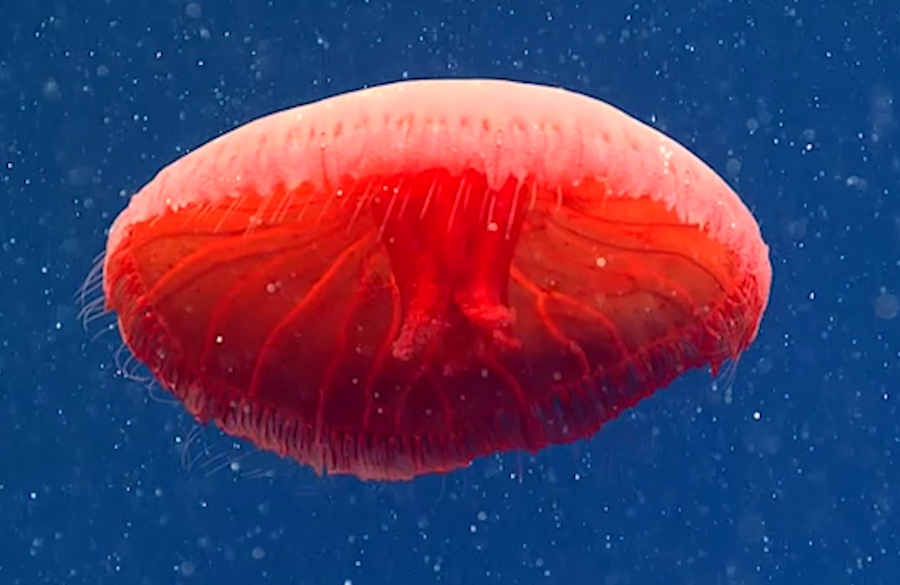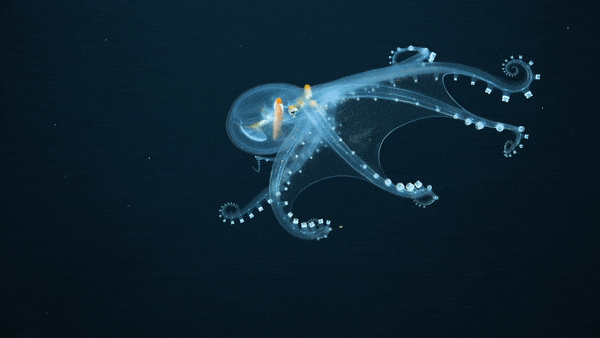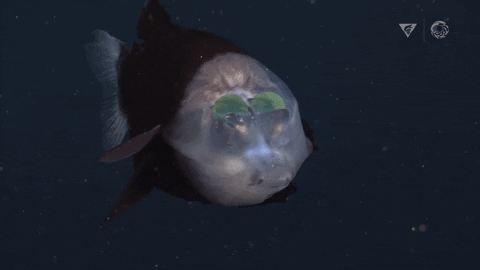10 weird creatures found in the deep sea in 2021
Shapeshifting fish, ghostly jellies, stunning cephalopods and more.
If you're looking for bizarre creatures that defy explanation, there is no better place to look than the deep sea. Every year, researchers capture incredible footage of alien-looking animals and strange new species lurking in the deep, and this year was no different. Here is our list of the top 10 weirdest deep-sea creatures seen in 2021.
Blood-red jellyfish
In August, researchers with the National Oceanic and Atmospheric Administration (NOAA) announced the discovery of a brand-new and unnamed species of blood-red jellyfish. The dark red jelly likely belongs to the genus Poralia, according to the researchers.
They first spotted the new jelly on July 28 using a remotely operated vehicle (ROV) at a depth of around 2,300 feet (700 meters) just off the coast of Newport, Rhode Island. Other animals, including other cnidarians (jellyfish & corals), ctenophores (comb jellies), crustaceans and Actinopterygii (ray-finned fishes), were also seen on the dive.
Lots of deep-sea creatures have evolved a similar red color because red wavelengths of light do not penetrate into the deep ocean. This means that red animals appear black because there is no red light to reflect back toward potential predators.
Read more: Mysterious blood-red jellyfish may be rare species unknown to science, researchers say
Elusive glass octopus
Also in August, researchers from the Schmidt Ocean Institute (SOI) released footage of an elusive glass octopus (Vitreledonella richardi) off the coast of the remote Phoenix Islands, an archipelago located more than 3,200 miles (5,100 km) northeast of Sydney, Australia.
The translucent cephalopod was originally discovered during a 34-day expedition of the Central Pacific Ocean onboard the SOI's research vessel Falkor. Onboard scientists spotted the creature using the ROV SuBastian, which spent a total of 182 hours scanning the seafloor during the expedition.
Get the world’s most fascinating discoveries delivered straight to your inbox.
Like other "glass" creatures, such as glass frogs and certain comb jellies, glass octopuses are almost completely transparent, with only their cylindrical eyes, optic nerve and digestive tract appearing opaque.
Read more: Elusive glass octopus spotted in the remote Pacific Ocean (Video)
Shape-shifting whalefish
The Monterey Bay Aquarium Research Institute (MBARI) released footage in August showing a bright orange, female whalefish (of the order Cetomimiformes) around 6,600 feet (2,013 m) deep offshore of Monterey Bay, California.
Very little is known about this bizarre fish because of the three drastically different appearances of the juveniles (tapetails), males (bignoses) and females (whalefish). The three forms look so different that scientists originally thought they were three different species. The shape-shifting transformation from juvenile to mature females is believed to be one of the most extreme among any vertebrates.
"Whalefish have rarely been seen alive in the deep, so many mysteries remain regarding these remarkable fish," the Monterey Bay Aquarium Research Institute tweeted.
Read more: Shape-shifting fish that confounded scientists for 100 years spotted off California coast
'Emperor Dumbo'
In May, researchers reported the discovery of a brand new species of Dumbo octopus (Grimpteuthis imperator), nicknamed "Emperor Dumbo" by the researchers.
Researchers discovered the adorable creature in 2016 when they accidentally dragged it to the surface in a net while aboard the German research vessel Sonne during an expedition of the Aleutian Islands in the Bering Sea. Dumbo octopus species can be identified by the umbrella-like webbing joining their tentacles and their cartoonishly ear-like fins that resemble the oversized ears on Disney's famous elephant.
"It was a really lucky find," Alexander Ziegler, a researcher at Friedrich Wilhelm University in Bonn, Germany, and chief scientist onboard the research vessel, told Live Science, "because we weren't really looking for it. Plus, the whole animal came to the surface intact."
Read more: All hail 'Emperor Dumbo,' the newest species of deep-dwelling octopus
Real-life SpongeBob and Patrick
In August, NOAA released a comical photo of the real-life counterparts of the cartoon best friends SpongeBob Squarepants and Patrick Star side-by-side on the seafloor.
The image of the square(ish) yellow sponge and five-pointed pink sea star were taken by an ROV on July 27, at a depth of 6,184 feet (1,885 m) during an expedition of the Retriever Seamount off the coast of New England.
"The sponge is [in] the genus Hertwigia and the sea star is [in] the genus Chondraster," Christopher Mah, a marine biologist at Smithsonian's National Museum of Natural History who first made the comparison on Twitter, told Live Science. The exact species is unclear, and they could even be brand new to science, he added.
Read more: Real-life SpongeBob and Patrick found side by side on seafloor. But they likely don't get along.
Alien-like spindly squid
In November, NOAA scientists spotted a rare bigfin squid (of the genus Magnapinna) with an ROV during an expedition in the Gulf of Mexico.
The ghostly squid has a very odd body plan with huge, iridescent fins and bizarre elbow-like bends in its tentacles. "All of their arms and tentacles have this long, spaghetti-like extension," Mike Vecchione, a research zoologist with the NOAA Fisheries National Systematics Laboratory, can be heard saying in the NOAA video footage. "It's really difficult to tell the arms from the tentacles, which is very unusual for a squid."
To date, there have been fewer than 20 confirmed sightings of this deep-sea cephalopod since it was first discovered in 1998.
Read more: Eerie video captures elusive, alien-like squid gliding in the Gulf of Mexico
Giant phantom jellyfish
In November, MBARI released rare video footage of a giant phantom jellyfish (Stygiomedusa gigantea). Scientists operating an ROV at a depth of 3,200 feet (975 m) in Monterey Bay, California, spotted the massive jelly, with its 3.3-foot-wide (1 m) bell and 33-foot-long (10 m) ribbon-like arms.
Not much is known about phantom jellyfish, but scientists think it uses its arms, which stream like loose scarves in its wake, to ensnare unfortunate prey and winch them up to its mouth. The creature also propels itself through the pitch-black depths with periodic pulses from its faintly glowing bell.
"The giant phantom jelly was first collected in 1899. Since then, scientists have only encountered this animal about 100 times," MBARI said in a statement. Although it is rarely spotted, the jelly has been found in the depths of every major ocean in the world, except for the Arctic Ocean.
Read more: Giant 'phantom jellyfish' that eats with mouth-arms spotted off California coast
Photobombing squid
In October, researchers trying to map the seafloor of the Gulf of Aqaba in the Red Sea were shocked when they discovered a recent shipwreck from 2011. While trying to film the remains of the vessel, the team's ROV was continuously photobombed by a purpleback flying squid (Sthenoteuthis oualaniensis).
The shipwreck and squid were found at a depth of around 2,788 feet (850 m). The scientists from OceanX think it was a solitary squid, but it may have been more than one as it was hard to identify the cephalopod as it zoomed across the screen. The researchers also said the squid had a total body length of about 6 feet (2 m), which would be near the maximum size for the species.
"It was just so spectacular for me," Mattie Rodrigue, science program lead at OceanX, told Live Science. "We had absolutely no idea that we were going to encounter such a magnificent and large animal."
Read more: Giant purpleblack flying squid photobombs crew investigating shipwreck
Sponge tracks on the seafloor
In April, a new study revealed the first evidence of deep-sea sponges crawling around on the seafloor, after researchers snapped photos of bizarre brown tracks left behind by the surprisingly mobile creatures in the Arctic.
The sponge trails were first photographed in 2016 by towed cameras behind a research vessel at Langseth Ridge — a poorly studied region of the Arctic Ocean that's permanently covered in sea ice — at a depth of between 2,300 and 3,300 feet (700 to 1,000 meters).
"The trails are made up of the spicules, or spines, which the sponge can grow," study co-author Autun Purser, a deep-sea ecologist at the Alfred Wegener Institute at the Helmholtz Center for Polar and Marine Research in Germany, told Live Science. "The sponge seems to expand along these spines, then contract to the new, moved position. During this process, some spines break off, forming the trails."
Read more: Arctic sponges crawl around the seafloor and leave bizarre brown trails to prove it
A see through skull
In December, MBARI researchers caught a rare glimpse of a barreleye fish (Macropinna microstoma). This bizarre fish has a translucent forehead, which it actually looks through using a pair of bulbous green eyes inside its head.
An ROV filmed the strange creature while cruising at a depth of about 2,132 feet (650 m) in the Monterey Submarine Canyon, one of the deepest submarine canyons on the Pacific coast. Extraordinarily, MBARI scientists have only ever spotted the species nine times previously, despite having completed more than 5,600 dives in the fish's habitat.
"The barreleye first appeared very small out in the blue distance, but I immediately knew what I was looking at. It couldn't be mistaken for anything else," Thomas Knowles, a senior aquarist at the Monterey Bay Aquarium, told Live Science.
Read more: New footage shows bizarre deep-sea fish that sees through its forehead
Originally published on Live Science.

Harry is a U.K.-based senior staff writer at Live Science. He studied marine biology at the University of Exeter before training to become a journalist. He covers a wide range of topics including space exploration, planetary science, space weather, climate change, animal behavior and paleontology. His recent work on the solar maximum won "best space submission" at the 2024 Aerospace Media Awards and was shortlisted in the "top scoop" category at the NCTJ Awards for Excellence in 2023. He also writes Live Science's weekly Earth from space series.












